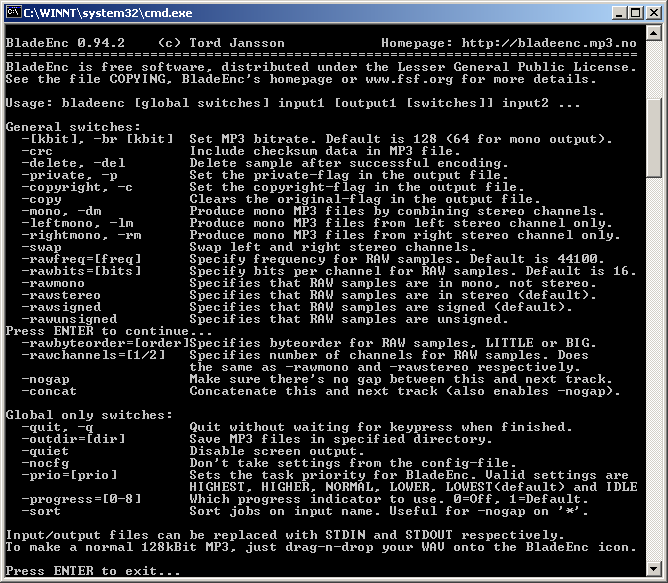Blade: Difference between revisions
(Removed an extra space.) |
|||
| (One intermediate revision by one other user not shown) | |||
| Line 1: | Line 1: | ||
BladeEnc is a freeware MP3 encoder. It is based on the same ISO compression routines as mpegEnc, so you can expect roughly the same, or better, quality . The main difference is the appearance and speed. BladeEnc doesn't have a nice, user-friendly interface like mpegEnc, but it is more than three times faster, and it works with several popular front-end graphical user interfaces . | BladeEnc is a freeware MP3 encoder. It is based on the same ISO compression routines as mpegEnc, so you can expect roughly the same, or better, quality. The main difference is the appearance and speed. BladeEnc doesn't have a nice, user-friendly interface like mpegEnc, but it is more than three times faster, and it works with several popular front-end graphical user interfaces . | ||
==Features== | ==Features== | ||
* Source code available under the LGPL | * Source code available under the LGPL license. | ||
* Stereo or Mono output. Can downmix to Mono on the fly. | * Stereo or Mono output. Can downmix to Mono on the fly. | ||
* Supports the following bitrates: 32, 40, 48, 56, 64, 80, 96, 112, 128, 160, 192, 224, 256 and 320 kBit/s. However, for bitrates lower than 128 kBit we seriously recommend you to use another encoder. | * Supports the following bitrates: 32, 40, 48, 56, 64, 80, 96, 112, 128, 160, 192, 224, 256 and 320 kBit/s. However, for bitrates lower than 128 kBit we seriously recommend you to use another encoder. | ||
Latest revision as of 19:17, 8 April 2022
BladeEnc is a freeware MP3 encoder. It is based on the same ISO compression routines as mpegEnc, so you can expect roughly the same, or better, quality. The main difference is the appearance and speed. BladeEnc doesn't have a nice, user-friendly interface like mpegEnc, but it is more than three times faster, and it works with several popular front-end graphical user interfaces .
Features
- Source code available under the LGPL license.
- Stereo or Mono output. Can downmix to Mono on the fly.
- Supports the following bitrates: 32, 40, 48, 56, 64, 80, 96, 112, 128, 160, 192, 224, 256 and 320 kBit/s. However, for bitrates lower than 128 kBit we seriously recommend you to use another encoder.
- Flags like Private, Original and Copyright can be set.
- Input samples can be in either 32, 44.1 or 48 kHz.
- Both 8 and 16-bit samples are supported.
- Working CRC checksum generation (since 0.80). The ISO reference code had broken CRC calculations, which has been inherited into every ISO based encoder that haven't added a fix for it.
- Can be compiled for nearly any operating system still in use.
- Commandline based, makes it easy to include BladeEnc into BAT files and shell scripts.
- Reads standard uncompressed WAV- and AIFF-files as well as well as RAW PCM-data.
- Batch encoding. Can encode any number of samples in a row.
- Wildcards supported. You can for example encode all WAV-files in a directory by typing "*.WAV".
- Input samples can be automatically deleted after encoding.
- Large selection of graphical frontends available.
- Task priority can be set from the commandline and is by default set to LOWEST so that you still can use your computer effectively while encoding (Windows & OS/2 only).
- Full support for pipes and redirection (stdin and stdout).
- Textbased configuration file where you can change default settings.
Screenshot

